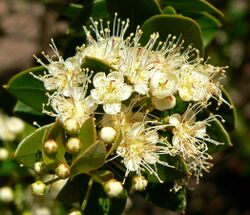Biology:Amomyrtus meli
| Meli | |
|---|---|

| |
| Scientific classification | |
| Kingdom: | Plantae |
| Clade: | Tracheophytes |
| Clade: | Angiosperms |
| Clade: | Eudicots |
| Clade: | Rosids |
| Order: | Myrtales |
| Family: | Myrtaceae |
| Genus: | Amomyrtus |
| Species: | A. meli
|
| Binomial name | |
| Amomyrtus meli (Phil.) D.Legrand & Kausel
| |
Amomyrtus meli, known as meli, is a species of tree in the family Myrtaceae. It is endemic to Chile and grows from Arauco to Chiloe (37 to 42°S). It grows mostly on moist and shaded sites.[2]
Description
It is an evergreen tree that measures up to 20 m (65 ft) tall and up to 60 cm (23 in) in diameter, with smooth, decorticant bark of reddish-whitish color. The leaves are opposite, oval, lanceolate or elliptical with acute apex which ends in a mucro up to 1 mm long. The leaves are 2–5 long and 0.7–2.5 cm wide, the petioles are 2–4 mm long. Newly shoots are glabrous what make it different from Amomyrtus luma, species to which it resembles very much. The flowers are hermaphrodite, 5 fused sepals and 5 free white petals about 3–4 mm long. The stamens are numerous 40–80 and 5–7 mm long. The fruit is a black purplish-black berry, 5–8 mm in diameter, generally with 3 seeds about 3–4.5 mm.[citation needed]
Etymology
The name Amomyrtus from the Greek Amos, very fragrant; Myrtus is the family's name and Meli is the indigenous mapuche name of the tree.[3]
Taxonomy
Amomyrtus meli was first described by Rodolfo Amando Philippi in 1856, and in 1947 by D.Legrand & Kausel.[4][5]
Cultivation and uses
The wood is extremely hard and resistant and that is why it is used for elaborating tool handles; it is also planted as an ornamental tree because it blooms abundantly and is very fragrant. Its flowers are important for honey production.
References
- ↑ Botanic Gardens Conservation International (BGCI); IUCN SSC Global Tree Specialist Group (2018). "Amomyrtus meli". IUCN Red List of Threatened Species 2018: e.T131396314A135697499. doi:10.2305/IUCN.UK.2018-2.RLTS.T131396314A135697499.en. https://www.iucnredlist.org/species/131396314/135697499. Retrieved 28 February 2023.
- ↑ García, N.; C. Ormazábal (in spanish). Árboles Nativos de Chile. Santiago: Enersis S.A.. p. 196. http://www.chilebosque.cl/libroarbolesnativos.html.
- ↑ Zúñiga, Fernando (2022) (in es). Mapudungun. El habla mapuche. Fondo de Cultura Económica. ISBN 9789562892490.
- ↑ https://tropicos.org/name/22101457
- ↑ WFO (2023): Amomyrtus meli (Phil.) D.Legrand & Kausel. Published on the Internet;http://www.worldfloraonline.org/taxon/wfo-0000962868. Accessed on: 02 Apr 2023
External links
- "Amomyrtus meli". Enciclopedia de la Flora Chilena. http://www.florachilena.cl/Niv_tax/Angiospermas/Ordenes/Myrtales/Myrtaceae/Amomyrtus/Meli/Amomyrtus%20meli.htm. Retrieved 2010-04-06.
- "Amomyrtus meli". Chilebosque. Archived from the original on 19 April 2010. https://web.archive.org/web/20100419120844/http://www.chilebosque.cl/tree/ameli.html. Retrieved 2010-04-06.
Wikidata ☰ Q2841508 entry
 |


